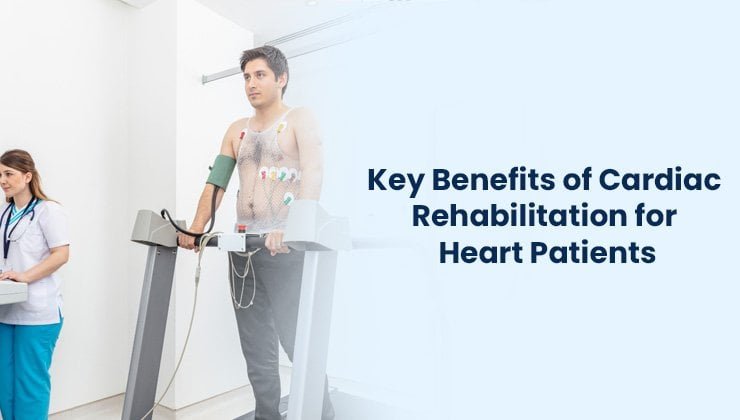Cardiac rehabilitation is a structured, supportive program designed to help rebuild strength and improve heart health following a cardiac event or surgery. Whether you are beginning your recovery journey or looking to prevent future heart problems, a cardiac rehabilitation program offers the tools that help you to return to a healthier active life.
In this blog post, we will explore the benefits of cardiac rehabilitation and how it can impact the lives of heart patients!
Understanding Cardiac Rehabilitation
Cardiac rehabilitation is a comprehensive, medically supervised program tailored to improve cardiovascular health, especially for individuals recovering from a heart attack, heart failure, cardiomyopathies, certain congenital heart diseases, angioplasty, or heart surgery.
It helps regain control of their health and lowers the risk of another cardiac event in the future by adopting a healthier diet, losing weight, reducing stress, and increasing energy levels.
It usually takes about 3-4 weeks supervised by a team of healthcare professionals, exercise and nutrition specialists, physical therapists, and counselors to assist the patients.
Who Needs Cardiac Rehabilitation?
Cardiac rehabilitation may be required for any individuals who have experienced or are at high risk of heart-related conditions.
It helps improve the heart health of
- Individuals who have had a heart attack
- Individuals after heart surgery
- Patients who have undergone angioplasty or stent replacement
- People with chronic stable angina
- Individuals with heart failure
- Individuals who have had a heart transplant
However, women and older adults are less likely to join a cardiac rehabilitation program.
Phases Of Cardiac Rehabilitation
Cardiac rehabilitation may begin before the hospital discharge and continues long-term. The different phases are
- Phase 1 (Inpatient): Inpatient when the individual is still in the hospital and begins immediately after a cardiac event. It includes education on stress management and gentle bedside exercises.
- Phase 2 (Outpatient): Outpatient begins once the patient is stable. It starts shortly after hospital discharge and includes structured exercises to strengthen the heart and education on lifestyle changes.
- Phase 3 (Maintenance): At home phase focusing on flexibility, strength, and aerobic conditioning for long-term heart health.
What To Expect During Cardiac Rehabilitation?
Cardiac rehabilitation is a supervised program that includes a combination of exercise training, heart health education, diet and nutrition counselling, and emotional support. The different components of cardiac rehabilitation include
- Exercise training: A personalised exercise program includes resistance training, exercise training, stability training, coordination and yoga to improve flexibility. It provides education and support for an at-home exercise routine.
- Education about Lifestyle modification: It includes eating a nutritious diet, cessation of smoking, control of blood pressure and diabetes and avoiding overweight. A nutritionist will help in providing information about healthy eating choices and setting goals for weight loss or making a nutritious plan.
- Psychological intervention: It includes reducing stress and anxiety through medicine and talk therapy, and developing motivation
Benefits Of Cardiac Rehabilitation
Cardiac rehabilitation offers a wide range of benefits that contribute to overall well-being and long-term heart health.
- Improved Heart Health
One of the most significant benefits of cardiac rehabilitation is improved heart health. These programs help to strengthen the heart, improve blood circulation, and overall cardiovascular health.
- Relieves Heart-related Symptoms
Cardiac rehabilitation helps relieve heart-related symptoms, including chest pain, shortness of breath, and fatigue. As patients adopt healthier habits and build cardiovascular fitness, they become better equipped to manage activities without triggering symptoms.
- Reduces Stress
Stress is a major contributor to heart disease and delays the recovery process. Cardiac rehabilitation helps patients to reduce stress by adopting different techniques, including deep breathing, mindfulness, relaxation training, and psychological counselling.
- Improves Mood
Many patients experience anxiety, depression, or emotional distress after a cardiac event. Cardiac rehabilitation helps in addressing the mental well-being and improving mood of these patients through counselling, support groups, and regular physical activity.
- Increases Energy and Strength
Many patients lack energy and strength after a cardiac event or surgery. A structured exercise plan helps improve physical stamina and muscle strength, making it easier for patients to perform daily activities. It will help them gain confidence in resuming personal and professional responsibilities.
- Helps in Weight Management
Cardiac rehabilitation includes nutritional counselling and exercise regimen to help patients lose excess weight or maintain a healthy weight. Losing weight may also help in lowering the risk of associated cardiovascular conditions, including type 2 diabetes, high blood pressure, and high cholesterol.
- Reduces the Risk of Future Heart Problems
Cardiac rehabilitation through lifestyle changes, medication adherence, and regular monitoring significantly lowers the risk of future heart attacks, strokes, and cardiac conditions.
- Creates Awareness
Cardiac rehabilitation provides patients with education about their medical condition, medications, and lifestyle choices. It helps patients recognise warning signs early and make informed decisions about their treatment and daily habits.
- Improves Quality of Life
Patients who undergo cardiac rehabilitation often report improved sleep and a better sense of well-being. It also encourages them to participate in daily activities and hobbies. It further reduces healthcare costs.
Conclusion
Cardiac rehabilitation is an important part of recovery and long-term heart health through structured exercise, nutritional counselling, and education. It helps in improved quality of life, weight management, and reducing the risk of future heart problems.
If you are in Chennai and have any queries about cardiac rehabilitation, you may book a consultation with Dr Nikhil P J Thekumparampil for expert guidance and personalised care.
Frequently Asked Questions
The duration of cardiac rehabilitation may vary depending on medical needs, goals, and how the patients respond to exercise. It typically lasts three to four weeks, depending on the individual’s condition and progress. Some people may need long care as they may continue a long-term maintenance phase.
Not all aneurysms can be prevented, but certain lifestyle changes may significantly reduce the risk of Cardiac rehabilitation exercises may vary depending on the condition of the patients and the associated risk factors. It includes aerobic exercises, including walking, riding a stationary bike or using an elliptical or step trainer. It may also incorporate resistance training with light weights, flexibility exercises such as stretching, and balance activities.
Chronic stress may increase the risk of aneurysm by raising blood pressure and triggering inflammation Cardiac rehabilitation is generally safe for most people when it is properly prescribed and supervised by a healthcare professional. It includes medical evaluations and monitored exercises to reduce risks. However, people with underlying diseases require special precautions to ensure safety.
You may start cardiac rehabilitation as soon as your doctor says it is safe, usually within a few days to weeks after a cardiac event or surgery. Early participation, especially during the hospital stay or shortly after discharge, may help in recovery and improve outcomes. It may also help in reducing the risk of future heart problems.









